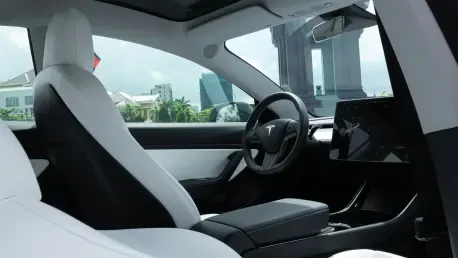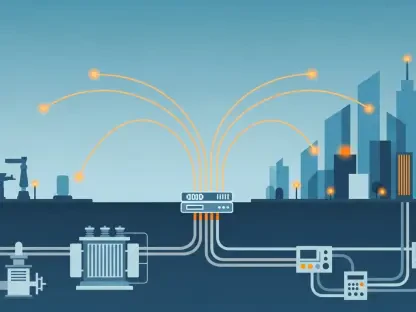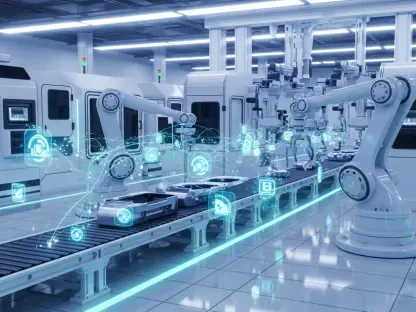Tesla, Inc. (NASDATSLA) has ignited a wave of excitement across financial markets with a striking surge in its stock price on October 6, 2025, fueled by heightened anticipation surrounding its Full Self-Driving (FSD) technology. This remarkable rally is not merely a fleeting moment of market fervor but a powerful signal of deep-rooted investor confidence in Tesla’s potential to redefine the future of transportation through autonomous innovation. The electric vehicle titan, long regarded as a trailblazer in the industry, stands at the forefront of a technological revolution that could reshape how people and goods move across the globe. With speculation swirling about imminent FSD breakthroughs or announcements, the market’s reaction underscores the high stakes tied to this technology and its promise of unlocking transformative revenue streams.
The broader implications of this surge extend far beyond Tesla’s balance sheet, pointing to a seismic shift in the automotive and mobility sectors. Investors are betting on Full Self-Driving (FSD) technology as a catalyst for new business models, from software subscriptions to autonomous ride-sharing networks, while also recognizing the competitive and regulatory challenges that lie ahead. As Tesla’s advancements continue to capture attention, the ripple effects are felt across industries, prompting competitors, suppliers, and policymakers to reassess their strategies in a rapidly evolving landscape. This moment serves as a snapshot of a future where technology, not just hardware, drives value—a trend that Tesla appears poised to lead with unwavering ambition.
Market Dynamics and Investor Sentiment
Tesla’s Stock Rally
The dramatic uptick in Tesla’s share price on October 6, 2025, has sent a clear message to the financial world: investors are placing significant faith in the company’s ability to deliver on its Full Self-Driving ambitions. This surge reflects more than just speculative hype; it embodies a collective belief that Tesla is on the cusp of a technological leap that could cement its position as the leader in autonomous mobility. Market analysts have noted that the rally aligns with growing chatter about potential FSD updates or milestones, which could further validate Tesla’s long-standing vision of a driverless future. The enthusiasm isn’t confined to short-term gains but signals a deeper trust in the company’s innovation pipeline, particularly its integration of artificial intelligence and software solutions that are increasingly seen as the backbone of modern transportation.
This investor optimism also highlights a broader trend in how the market evaluates companies within the mobility sector, showing a shift in priorities. Traditional metrics tied to manufacturing output are taking a backseat to technological prowess, with Tesla’s perceived edge in Full Self-Driving (FSD) technology acting as a key differentiator. The stock movement on this date serves as a barometer of confidence not just in Tesla, but in the transformative potential of autonomous systems to disrupt established norms. As capital continues to flow toward tech-driven enterprises, the rally underscores the high expectations placed on Tesla to turn its ambitious promises into tangible, market-ready solutions that can withstand scrutiny and competition.
Role of Elon Musk
Elon Musk’s influence on Tesla’s market perception remains a pivotal factor in driving investor sentiment, particularly in the context of Full Self-Driving (FSD) developments. Known for his bold pronouncements and aggressive timelines, Musk has a unique ability to shape expectations around Tesla’s technological advancements, often acting as a catalyst for stock volatility. His public statements, whether through social media or high-profile events, frequently ignite waves of excitement or skepticism among shareholders, with each comment dissected for clues about FSD’s progress. This dynamic positions Musk as more than just a CEO; he is a market mover whose vision of a fully autonomous future continues to captivate and polarize opinions in equal measure.
The impact of Musk’s rhetoric extends beyond mere speculation, as it often sets the tone for how Tesla’s capabilities are perceived against competitors, shaping public and investor confidence in the company’s future. His knack for framing Full Self-Driving (FSD) as an imminent reality, even amid technical and regulatory hurdles, keeps investors engaged and hopeful for breakthroughs that could redefine the company’s trajectory. While some critics argue that such optimism may overpromise on delivery timelines, there’s no denying that Musk’s ability to rally support has been instrumental in sustaining Tesla’s valuation during periods of uncertainty. This blend of visionary leadership and market influence remains a cornerstone of Tesla’s narrative, especially as FSD inches closer to becoming a commercial reality.
Full Self-Driving Technology as a Game-Changer
Evolution and Potential
Tesla’s journey with Full Self-Driving technology represents a bold evolution from its early Autopilot features to the ambitious goal of complete autonomy, a progression that has kept the company at the forefront of automotive innovation. Initially introduced as a driver-assist system, Autopilot laid the groundwork for more advanced capabilities, with FSD now promising a future where vehicles operate without human intervention. This shift isn’t just technical; it’s a reimagining of Tesla’s role in the market, moving from a hardware-focused manufacturer to a software-driven enterprise. The potential for recurring revenue through FSD subscriptions and autonomous services signals a transformative pivot that could redefine the company’s financial landscape over the coming years.
Beyond the balance sheet, the implications of Full Self-Driving (FSD) technology touch on how transportation itself is conceptualized, reshaping our understanding of mobility. A fully autonomous system could unlock efficiencies in both personal and commercial travel, reducing human error and optimizing traffic flow. Investors are particularly intrigued by the prospect of Tesla leveraging its vast data collection from millions of vehicles to refine FSD algorithms, creating a feedback loop that enhances performance over time. While challenges like safety validation persist, the vision of a world where vehicles seamlessly navigate complex environments drives the market’s enthusiasm. Tesla’s ability to deliver on this promise could set a new standard for what consumers expect from their cars, pushing the industry into uncharted territory.
Industry Ripple Effects
The impact of Tesla’s Full Self-Driving (FSD) advancements reverberates across the automotive sector, creating both opportunities and challenges for a wide array of stakeholders. Suppliers of critical components, such as NVIDIA (NASDANVDA) and Ambarella (NASDAAMBA), stand to gain significantly from the rising demand for AI hardware and software integral to autonomous systems. Their success is intricately tied to Tesla’s progress, as the push for FSD fuels a broader ecosystem of innovation that benefits those providing the technological building blocks. This interconnected growth highlights how Tesla’s leadership in autonomy isn’t just a solo endeavor but a rising tide that lifts adjacent industries focused on supporting next-generation mobility solutions.
Meanwhile, traditional automakers like General Motors (NYSE: GM) and Ford (NYSE: F) face mounting pressure to accelerate their own autonomous initiatives or risk being sidelined in a tech-centric market. Tesla’s perceived lead in Full Self-Driving (FSD) technology could shift consumer preferences toward vehicles equipped with cutting-edge software, threatening the relevance of legacy manufacturers. Simultaneously, ride-hailing companies such as Uber (NYSE: UBER) and Lyft (NASDALYFT) must navigate a dual reality: the promise of cost reductions through autonomous fleets and the looming threat of competition from a potential Tesla robotaxi network. This complex web of influence underscores how FSD isn’t merely a product feature but a disruptive force reshaping competitive dynamics and strategic priorities across multiple sectors.
Competitive Landscape in Autonomous Driving
Rivals and Technological Approaches
Tesla’s pursuit of Full Self-Driving technology places it in direct competition with formidable players like Waymo (Alphabet, NASDAGOOGL) and Cruise (GM, NYSE: GM), each vying for dominance in the autonomous driving arena. What sets this race apart is the diversity of technological approaches, with Tesla relying heavily on a vision-centric system powered by cameras and neural networks, while rivals often incorporate lidar and other sensor technologies for enhanced mapping and detection. This contrast in strategies reflects differing philosophies on how best to achieve safe and reliable autonomy, with Tesla betting on software sophistication over hardware redundancy. The outcome of this competition could dictate the industry standard for years to come, making every advancement a high-stakes endeavor.
The competitive pressure isn’t just about technology but also about public perception and investor confidence, which are crucial in shaping the future of autonomous vehicles. Waymo, for instance, has focused on limited, controlled deployments of autonomous vehicles in specific regions, aiming to build trust through gradual scaling. Cruise, backed by General Motors, emphasizes partnerships and regulatory alignment to smooth its path to market. Tesla, however, pushes for a broader, more ambitious rollout, leveraging its existing fleet to gather real-world data at an unparalleled scale. This aggressive approach, while risky, positions Tesla as a frontrunner in the eyes of many, though it must continuously prove its system’s reliability against competitors who prioritize incremental progress over bold promises.
Supplier and Partner Dynamics
As Tesla advances its Full Self-Driving (FSD) technology, the ripple effects are keenly felt by suppliers who play a critical role in the autonomous ecosystem, particularly companies like NVIDIA (NASDANVDA) and Ambarella (NASDAAMBA). These firms provide the high-performance computing power and imaging solutions essential for processing the vast amounts of data required for self-driving systems. The growing demand for such components, spurred by Tesla’s aggressive push toward autonomy, creates a lucrative market for suppliers, reinforcing their importance as partners in the broader technological shift. Their ability to innovate alongside Tesla and other automakers ensures that the supply chain evolves in tandem with the industry’s needs, amplifying the collective momentum toward a driverless future.
This dynamic also highlights the collaborative nature of achieving full autonomy, where no single company can succeed in isolation. Suppliers must navigate complex relationships with multiple players, balancing the needs of Tesla with those of competitors who may adopt different technological frameworks. The success of NVIDIA and Ambarella, for instance, hinges on their adaptability to varying demands, from vision-based systems to lidar-integrated platforms. As Tesla’s FSD efforts drive broader industry trends, these partnerships become a linchpin for scaling autonomous solutions, illustrating how interconnected the path to innovation truly is. The synergy between manufacturers and suppliers will likely shape the speed and scope of autonomy’s adoption across global markets.
Regulatory and Societal Implications
Government Challenges
The rollout of Full Self-Driving technology brings with it a host of regulatory challenges that governments worldwide must address to ensure safe and ethical integration into public spaces. Key issues include establishing safety standards, determining liability in the event of accidents, and safeguarding data privacy amid the massive collection of user information by autonomous systems. These concerns are compounded by the need to create consistent frameworks across jurisdictions, as differing regional policies could hinder the seamless deployment of FSD-equipped vehicles. While some areas may fast-track approvals to encourage innovation, others might impose stringent oversight, creating a fragmented landscape that Tesla and its peers must navigate with precision.
Beyond immediate policy hurdles, there’s the broader question of how regulators balance technological progress with public safety. Autonomous vehicles represent uncharted territory, requiring new legal paradigms that differ significantly from those governing traditional cars. Governments are tasked with anticipating risks, such as system failures or cybersecurity threats, while fostering an environment where innovation isn’t stifled. The outcome of these deliberations will play a decisive role in shaping the timeline for FSD adoption, as Tesla’s ability to deploy its technology at scale depends heavily on achieving regulatory harmony. This complex interplay between policy and progress remains a critical factor in the autonomous driving narrative.
Urban and Social Transformation
The societal impact of Full Self-Driving (FSD) technology extends far beyond the vehicle itself, promising to fundamentally alter urban planning and transportation economics in ways reminiscent of the automobile’s initial rise. With the potential to reduce traffic accidents caused by human error, FSD could lead to safer roads, prompting cities to rethink infrastructure investments and traffic management systems. Reduced congestion and optimized routing might also shrink the need for sprawling parking lots, freeing up urban space for green areas or development. Such changes signal a profound shift in how communities are designed, with autonomy acting as a catalyst for smarter, more sustainable cities over the long term.
Equally significant is the transformation of mobility as a societal concept, where access to autonomous vehicles could redefine personal freedom and economic opportunity, reshaping how we interact with transportation. Ride-sharing fleets powered by Full Self-Driving (FSD) technology might lower transportation costs, making mobility more accessible to underserved populations while challenging traditional ownership models. However, these benefits come with the need for public adaptation, as trust in driverless systems must be earned through consistent safety performance. The economic ripple effects, from job shifts in driving-related industries to new service sectors like in-car entertainment, further illustrate the depth of change on the horizon. As Tesla pushes forward with FSD, society stands at the cusp of a reimagined relationship with transportation.
Future Outlook for Tesla and Beyond
Short-Term Catalysts
In the near term, Tesla’s trajectory with Full Self-Driving technology hinges on specific catalysts that could sustain or amplify the investor momentum seen on October 6, 2025. Announcements regarding FSD milestones, such as expanded beta testing or regulatory approvals in key markets, have the potential to drive further stock gains by validating the company’s progress. Partnerships with municipalities for autonomous pilot programs or updates on software performance metrics could also serve as tangible proof points, reinforcing market confidence. These developments are crucial for maintaining the narrative of Tesla as an innovator on the brink of delivering a game-changing solution to the masses.
Investor attention will likely remain fixed on how quickly Tesla can translate technical advancements into real-world applications, especially as the company pushes forward with its ambitious goals. The rollout of features that bring Full Self-Driving (FSD) closer to full autonomy, even in limited scenarios, would signal to the market that the technology is nearing commercial viability. Additionally, clarity on timelines for robotaxi services or subscription-based FSD offerings could act as immediate boosts to Tesla’s valuation. While speculation abounds, the focus remains on concrete achievements that demonstrate reliability and scalability. These short-term triggers will play a pivotal role in shaping perceptions of Tesla’s ability to lead the autonomous revolution in the immediate future.
Long-Term Industry Shifts
Looking further ahead, the successful deployment of Full Self-Driving technology could redefine Tesla’s business model, pivoting the company toward recurring software revenue and service-based offerings that eclipse traditional vehicle sales. The vision of a subscription-driven FSD system, coupled with autonomous ride-sharing networks, points to a future where Tesla operates more as a tech platform than a car manufacturer. This shift could unlock new markets, from specialized insurance for autonomous fleets to smart infrastructure solutions that integrate with driverless ecosystems. The potential for sustained income streams through software updates and data monetization positions Tesla to dominate a reimagined mobility landscape.
Yet, the road to this long-term vision is fraught with complexities that extend beyond technology alone, and public acceptance remains a critical hurdle as widespread adoption of Full Self-Driving (FSD) depends on trust in its safety and reliability under diverse conditions. Scalability across global markets, each with unique regulatory and cultural nuances, adds another layer of challenge. Moreover, the emergence of adjacent industries, such as in-car entertainment tailored for autonomous travel, signals both opportunity and competition. Tesla’s ability to navigate these dynamics while maintaining its innovative edge will determine the extent to which it shapes the future of transportation. The industry stands at a crossroads, with FSD as the linchpin for a transformation that promises both profound change and persistent uncertainty.









